Applied Business Finance: Financial Management to Improve Performance
VerifiedAdded on 2023/06/17
|13
|2774
|324
Report
AI Summary
This report defines financial management, its importance, and its impact on business performance. It discusses key financial statements like the income statement, balance sheet, and cash flow statement, along with the use of ratio analysis for assessing profitability, liquidity, and efficiency. The report includes a case study analysis with calculations and interpretations of various financial ratios. It further explores strategies and processes that businesses can implement to enhance their financial performance, such as efficient resource allocation, cost reduction, and debt management. The report concludes by emphasizing the importance of proactive financial planning and control for achieving sustainable business growth. Desklib provides access to a variety of solved assignments and past papers.
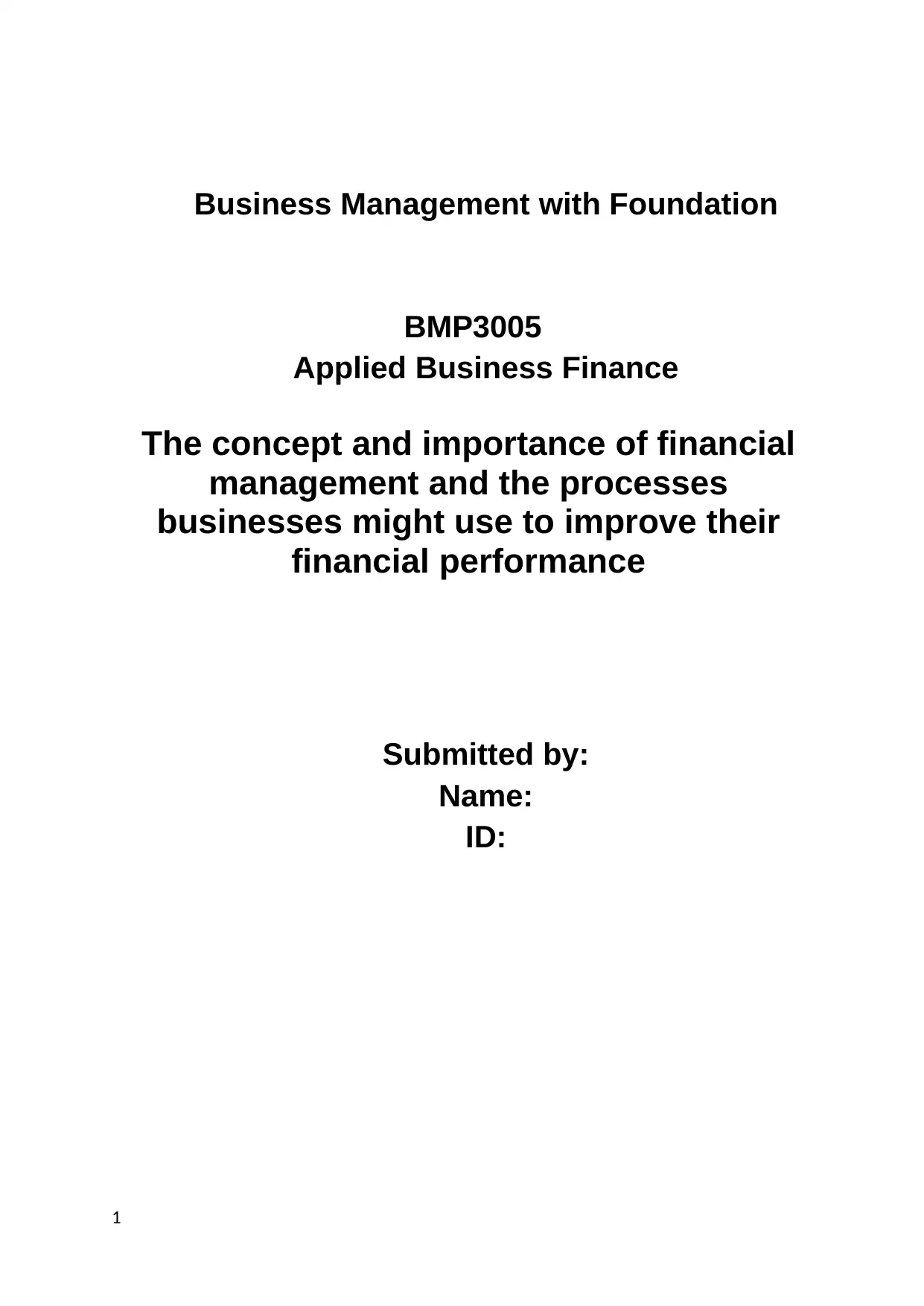
Business Management with Foundation
BMP3005
Applied Business Finance
The concept and importance of financial
management and the processes
businesses might use to improve their
financial performance
Submitted by:
Name:
ID:
1
BMP3005
Applied Business Finance
The concept and importance of financial
management and the processes
businesses might use to improve their
financial performance
Submitted by:
Name:
ID:
1
Paraphrase This Document
Need a fresh take? Get an instant paraphrase of this document with our AI Paraphraser
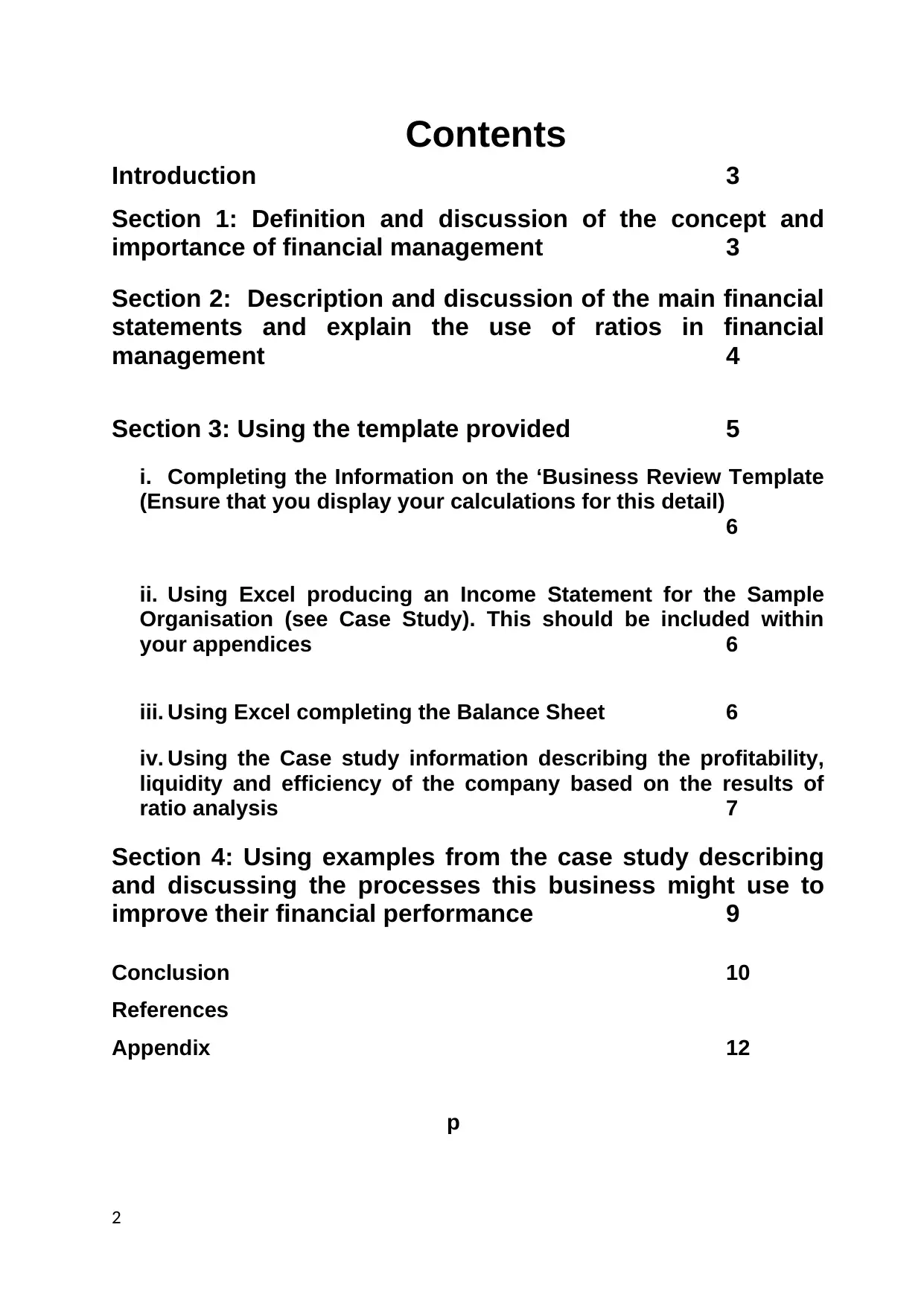
Contents
Introduction 3
Section 1: Definition and discussion of the concept and
importance of financial management 3
Section 2: Description and discussion of the main financial
statements and explain the use of ratios in financial
management 4
Section 3: Using the template provided 5
i. Completing the Information on the ‘Business Review Template
(Ensure that you display your calculations for this detail)
6
ii. Using Excel producing an Income Statement for the Sample
Organisation (see Case Study). This should be included within
your appendices 6
iii. Using Excel completing the Balance Sheet 6
iv. Using the Case study information describing the profitability,
liquidity and efficiency of the company based on the results of
ratio analysis 7
Section 4: Using examples from the case study describing
and discussing the processes this business might use to
improve their financial performance 9
Conclusion 10
References
Appendix 12
p
2
Introduction 3
Section 1: Definition and discussion of the concept and
importance of financial management 3
Section 2: Description and discussion of the main financial
statements and explain the use of ratios in financial
management 4
Section 3: Using the template provided 5
i. Completing the Information on the ‘Business Review Template
(Ensure that you display your calculations for this detail)
6
ii. Using Excel producing an Income Statement for the Sample
Organisation (see Case Study). This should be included within
your appendices 6
iii. Using Excel completing the Balance Sheet 6
iv. Using the Case study information describing the profitability,
liquidity and efficiency of the company based on the results of
ratio analysis 7
Section 4: Using examples from the case study describing
and discussing the processes this business might use to
improve their financial performance 9
Conclusion 10
References
Appendix 12
p
2
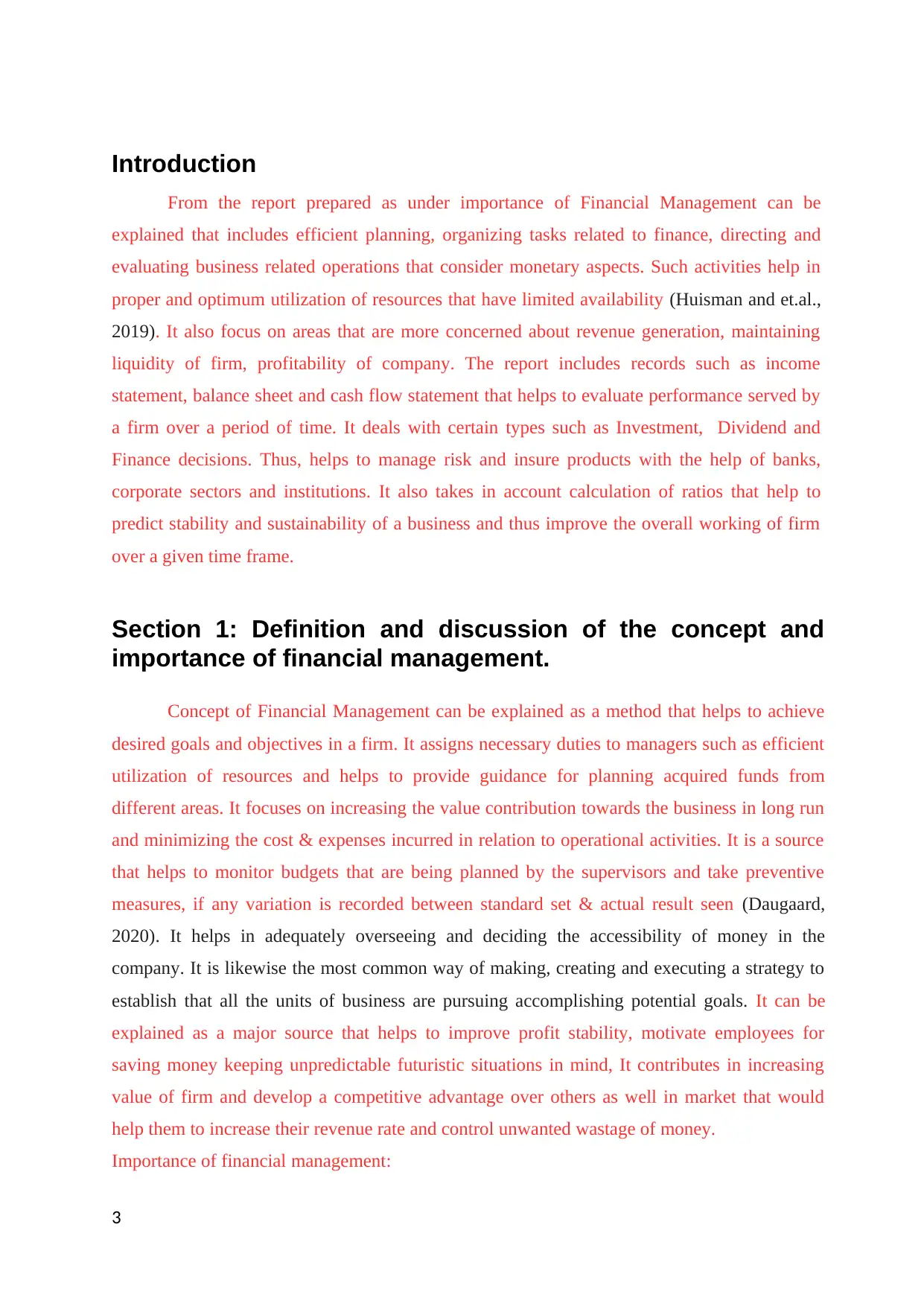
Introduction
From the report prepared as under importance of Financial Management can be
explained that includes efficient planning, organizing tasks related to finance, directing and
evaluating business related operations that consider monetary aspects. Such activities help in
proper and optimum utilization of resources that have limited availability (Huisman and et.al.,
2019). It also focus on areas that are more concerned about revenue generation, maintaining
liquidity of firm, profitability of company. The report includes records such as income
statement, balance sheet and cash flow statement that helps to evaluate performance served by
a firm over a period of time. It deals with certain types such as Investment, Dividend and
Finance decisions. Thus, helps to manage risk and insure products with the help of banks,
corporate sectors and institutions. It also takes in account calculation of ratios that help to
predict stability and sustainability of a business and thus improve the overall working of firm
over a given time frame.
Section 1: Definition and discussion of the concept and
importance of financial management.
Concept of Financial Management can be explained as a method that helps to achieve
desired goals and objectives in a firm. It assigns necessary duties to managers such as efficient
utilization of resources and helps to provide guidance for planning acquired funds from
different areas. It focuses on increasing the value contribution towards the business in long run
and minimizing the cost & expenses incurred in relation to operational activities. It is a source
that helps to monitor budgets that are being planned by the supervisors and take preventive
measures, if any variation is recorded between standard set & actual result seen (Daugaard,
2020). It helps in adequately overseeing and deciding the accessibility of money in the
company. It is likewise the most common way of making, creating and executing a strategy to
establish that all the units of business are pursuing accomplishing potential goals. It can be
explained as a major source that helps to improve profit stability, motivate employees for
saving money keeping unpredictable futuristic situations in mind, It contributes in increasing
value of firm and develop a competitive advantage over others as well in market that would
help them to increase their revenue rate and control unwanted wastage of money.
Importance of financial management:
3
From the report prepared as under importance of Financial Management can be
explained that includes efficient planning, organizing tasks related to finance, directing and
evaluating business related operations that consider monetary aspects. Such activities help in
proper and optimum utilization of resources that have limited availability (Huisman and et.al.,
2019). It also focus on areas that are more concerned about revenue generation, maintaining
liquidity of firm, profitability of company. The report includes records such as income
statement, balance sheet and cash flow statement that helps to evaluate performance served by
a firm over a period of time. It deals with certain types such as Investment, Dividend and
Finance decisions. Thus, helps to manage risk and insure products with the help of banks,
corporate sectors and institutions. It also takes in account calculation of ratios that help to
predict stability and sustainability of a business and thus improve the overall working of firm
over a given time frame.
Section 1: Definition and discussion of the concept and
importance of financial management.
Concept of Financial Management can be explained as a method that helps to achieve
desired goals and objectives in a firm. It assigns necessary duties to managers such as efficient
utilization of resources and helps to provide guidance for planning acquired funds from
different areas. It focuses on increasing the value contribution towards the business in long run
and minimizing the cost & expenses incurred in relation to operational activities. It is a source
that helps to monitor budgets that are being planned by the supervisors and take preventive
measures, if any variation is recorded between standard set & actual result seen (Daugaard,
2020). It helps in adequately overseeing and deciding the accessibility of money in the
company. It is likewise the most common way of making, creating and executing a strategy to
establish that all the units of business are pursuing accomplishing potential goals. It can be
explained as a major source that helps to improve profit stability, motivate employees for
saving money keeping unpredictable futuristic situations in mind, It contributes in increasing
value of firm and develop a competitive advantage over others as well in market that would
help them to increase their revenue rate and control unwanted wastage of money.
Importance of financial management:
3
⊘ This is a preview!⊘
Do you want full access?
Subscribe today to unlock all pages.

Trusted by 1+ million students worldwide
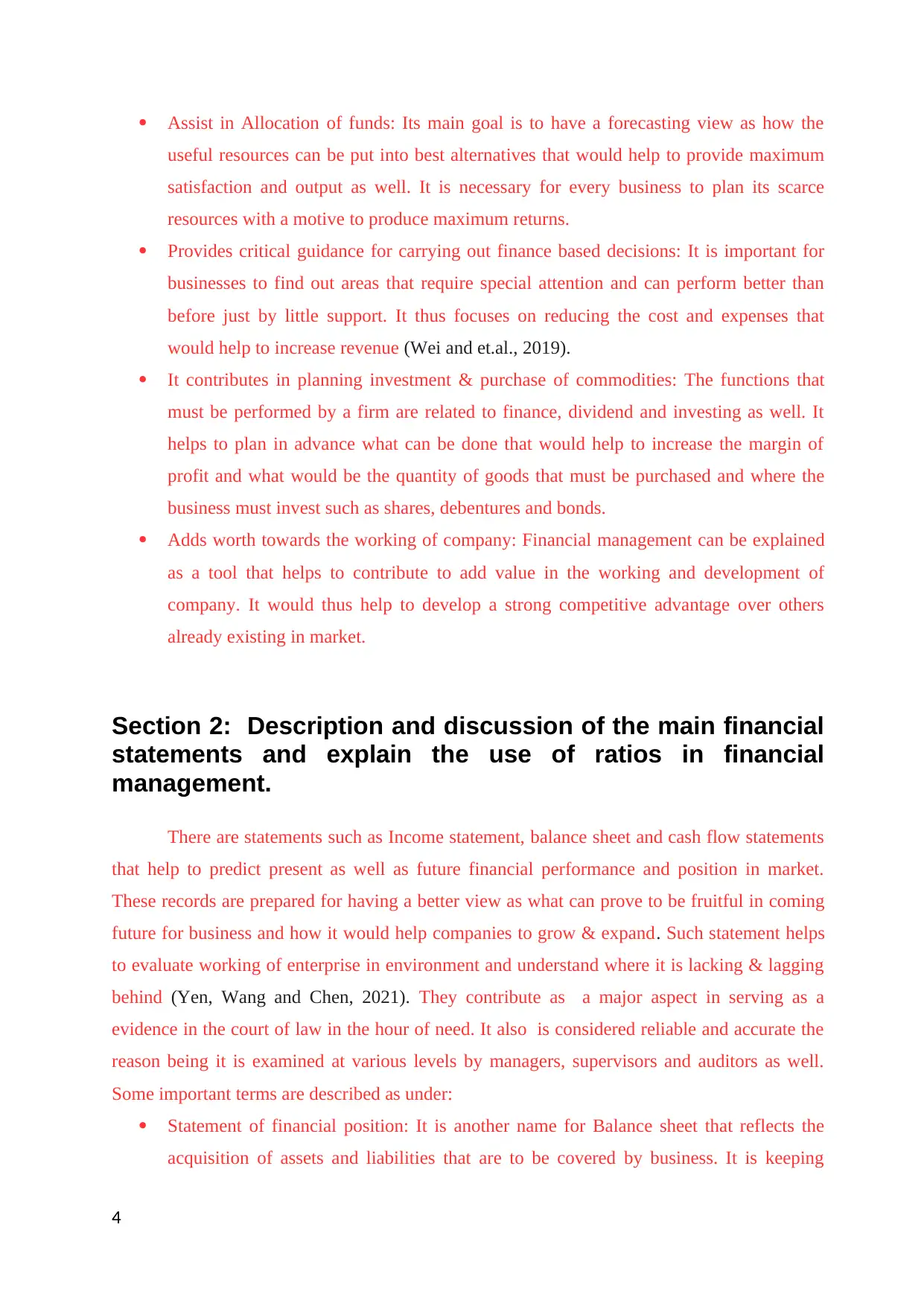
Assist in Allocation of funds: Its main goal is to have a forecasting view as how the
useful resources can be put into best alternatives that would help to provide maximum
satisfaction and output as well. It is necessary for every business to plan its scarce
resources with a motive to produce maximum returns.
Provides critical guidance for carrying out finance based decisions: It is important for
businesses to find out areas that require special attention and can perform better than
before just by little support. It thus focuses on reducing the cost and expenses that
would help to increase revenue (Wei and et.al., 2019).
It contributes in planning investment & purchase of commodities: The functions that
must be performed by a firm are related to finance, dividend and investing as well. It
helps to plan in advance what can be done that would help to increase the margin of
profit and what would be the quantity of goods that must be purchased and where the
business must invest such as shares, debentures and bonds.
Adds worth towards the working of company: Financial management can be explained
as a tool that helps to contribute to add value in the working and development of
company. It would thus help to develop a strong competitive advantage over others
already existing in market.
Section 2: Description and discussion of the main financial
statements and explain the use of ratios in financial
management.
There are statements such as Income statement, balance sheet and cash flow statements
that help to predict present as well as future financial performance and position in market.
These records are prepared for having a better view as what can prove to be fruitful in coming
future for business and how it would help companies to grow & expand. Such statement helps
to evaluate working of enterprise in environment and understand where it is lacking & lagging
behind (Yen, Wang and Chen, 2021). They contribute as a major aspect in serving as a
evidence in the court of law in the hour of need. It also is considered reliable and accurate the
reason being it is examined at various levels by managers, supervisors and auditors as well.
Some important terms are described as under:
Statement of financial position: It is another name for Balance sheet that reflects the
acquisition of assets and liabilities that are to be covered by business. It is keeping
4
useful resources can be put into best alternatives that would help to provide maximum
satisfaction and output as well. It is necessary for every business to plan its scarce
resources with a motive to produce maximum returns.
Provides critical guidance for carrying out finance based decisions: It is important for
businesses to find out areas that require special attention and can perform better than
before just by little support. It thus focuses on reducing the cost and expenses that
would help to increase revenue (Wei and et.al., 2019).
It contributes in planning investment & purchase of commodities: The functions that
must be performed by a firm are related to finance, dividend and investing as well. It
helps to plan in advance what can be done that would help to increase the margin of
profit and what would be the quantity of goods that must be purchased and where the
business must invest such as shares, debentures and bonds.
Adds worth towards the working of company: Financial management can be explained
as a tool that helps to contribute to add value in the working and development of
company. It would thus help to develop a strong competitive advantage over others
already existing in market.
Section 2: Description and discussion of the main financial
statements and explain the use of ratios in financial
management.
There are statements such as Income statement, balance sheet and cash flow statements
that help to predict present as well as future financial performance and position in market.
These records are prepared for having a better view as what can prove to be fruitful in coming
future for business and how it would help companies to grow & expand. Such statement helps
to evaluate working of enterprise in environment and understand where it is lacking & lagging
behind (Yen, Wang and Chen, 2021). They contribute as a major aspect in serving as a
evidence in the court of law in the hour of need. It also is considered reliable and accurate the
reason being it is examined at various levels by managers, supervisors and auditors as well.
Some important terms are described as under:
Statement of financial position: It is another name for Balance sheet that reflects the
acquisition of assets and liabilities that are to be covered by business. It is keeping
4
Paraphrase This Document
Need a fresh take? Get an instant paraphrase of this document with our AI Paraphraser
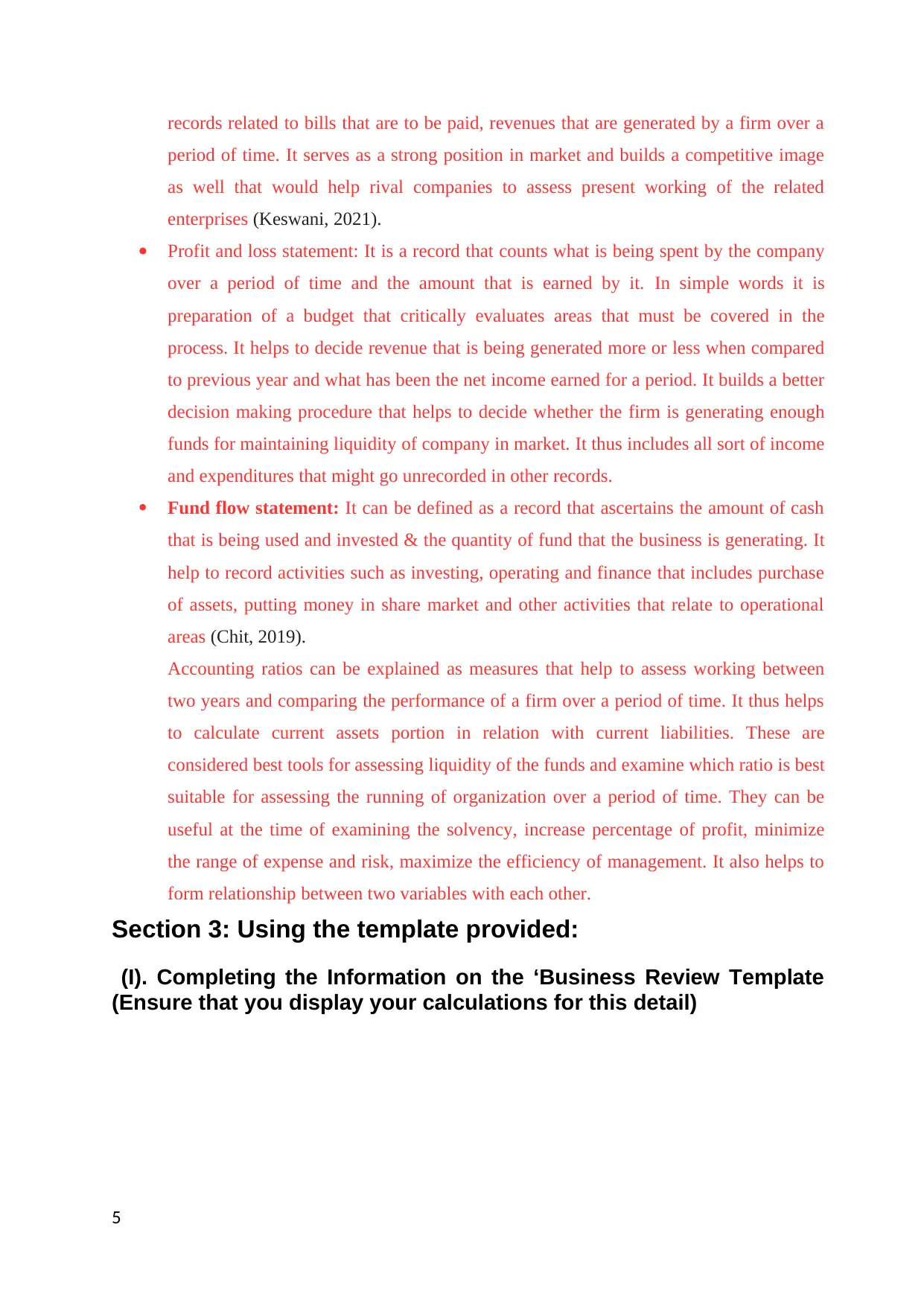
records related to bills that are to be paid, revenues that are generated by a firm over a
period of time. It serves as a strong position in market and builds a competitive image
as well that would help rival companies to assess present working of the related
enterprises (Keswani, 2021).
Profit and loss statement: It is a record that counts what is being spent by the company
over a period of time and the amount that is earned by it. In simple words it is
preparation of a budget that critically evaluates areas that must be covered in the
process. It helps to decide revenue that is being generated more or less when compared
to previous year and what has been the net income earned for a period. It builds a better
decision making procedure that helps to decide whether the firm is generating enough
funds for maintaining liquidity of company in market. It thus includes all sort of income
and expenditures that might go unrecorded in other records.
Fund flow statement: It can be defined as a record that ascertains the amount of cash
that is being used and invested & the quantity of fund that the business is generating. It
help to record activities such as investing, operating and finance that includes purchase
of assets, putting money in share market and other activities that relate to operational
areas (Chit, 2019).
Accounting ratios can be explained as measures that help to assess working between
two years and comparing the performance of a firm over a period of time. It thus helps
to calculate current assets portion in relation with current liabilities. These are
considered best tools for assessing liquidity of the funds and examine which ratio is best
suitable for assessing the running of organization over a period of time. They can be
useful at the time of examining the solvency, increase percentage of profit, minimize
the range of expense and risk, maximize the efficiency of management. It also helps to
form relationship between two variables with each other.
Section 3: Using the template provided:
(I). Completing the Information on the ‘Business Review Template
(Ensure that you display your calculations for this detail)
5
period of time. It serves as a strong position in market and builds a competitive image
as well that would help rival companies to assess present working of the related
enterprises (Keswani, 2021).
Profit and loss statement: It is a record that counts what is being spent by the company
over a period of time and the amount that is earned by it. In simple words it is
preparation of a budget that critically evaluates areas that must be covered in the
process. It helps to decide revenue that is being generated more or less when compared
to previous year and what has been the net income earned for a period. It builds a better
decision making procedure that helps to decide whether the firm is generating enough
funds for maintaining liquidity of company in market. It thus includes all sort of income
and expenditures that might go unrecorded in other records.
Fund flow statement: It can be defined as a record that ascertains the amount of cash
that is being used and invested & the quantity of fund that the business is generating. It
help to record activities such as investing, operating and finance that includes purchase
of assets, putting money in share market and other activities that relate to operational
areas (Chit, 2019).
Accounting ratios can be explained as measures that help to assess working between
two years and comparing the performance of a firm over a period of time. It thus helps
to calculate current assets portion in relation with current liabilities. These are
considered best tools for assessing liquidity of the funds and examine which ratio is best
suitable for assessing the running of organization over a period of time. They can be
useful at the time of examining the solvency, increase percentage of profit, minimize
the range of expense and risk, maximize the efficiency of management. It also helps to
form relationship between two variables with each other.
Section 3: Using the template provided:
(I). Completing the Information on the ‘Business Review Template
(Ensure that you display your calculations for this detail)
5
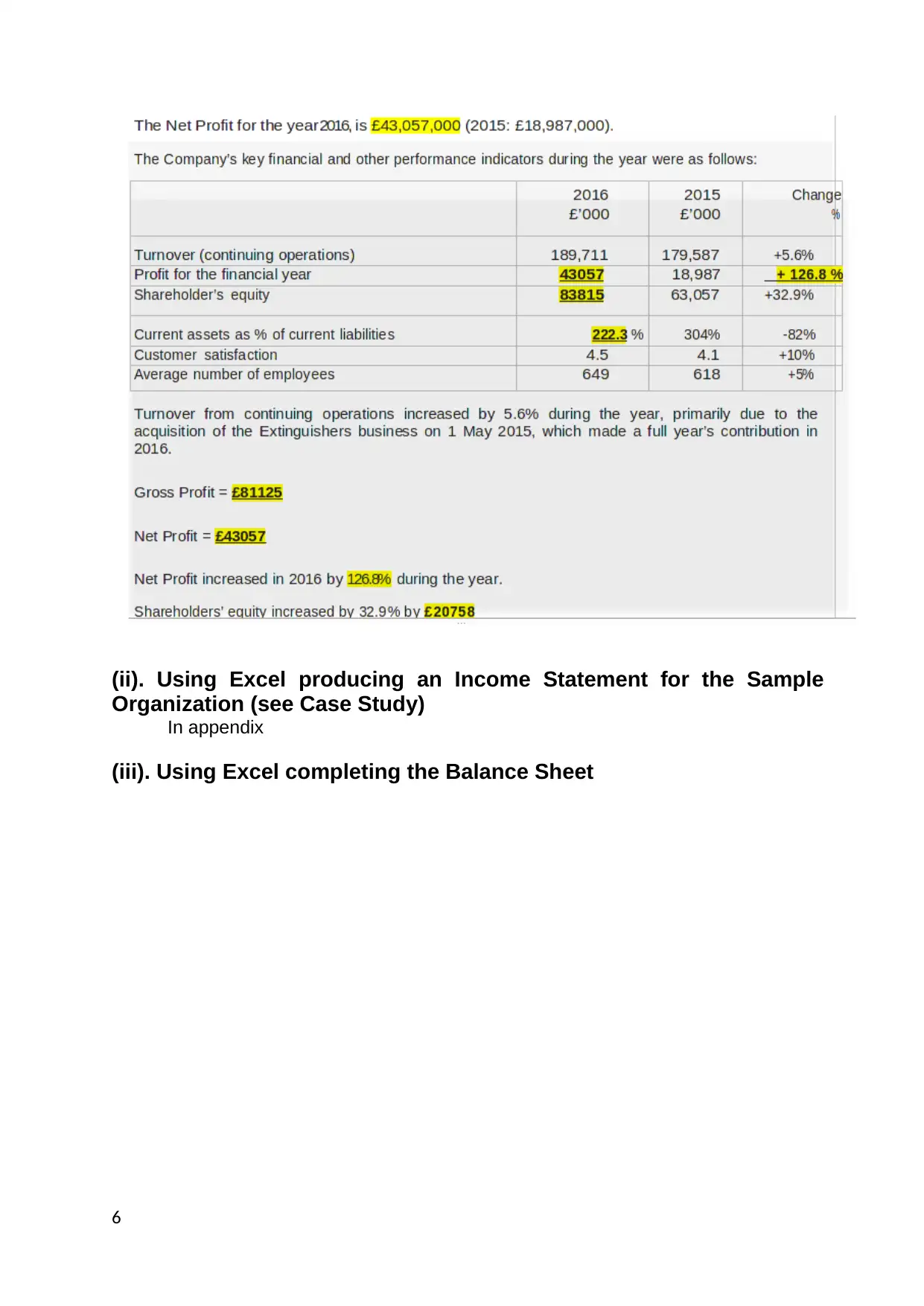
(ii). Using Excel producing an Income Statement for the Sample
Organization (see Case Study)
In appendix
(iii). Using Excel completing the Balance Sheet
6
Organization (see Case Study)
In appendix
(iii). Using Excel completing the Balance Sheet
6
⊘ This is a preview!⊘
Do you want full access?
Subscribe today to unlock all pages.

Trusted by 1+ million students worldwide
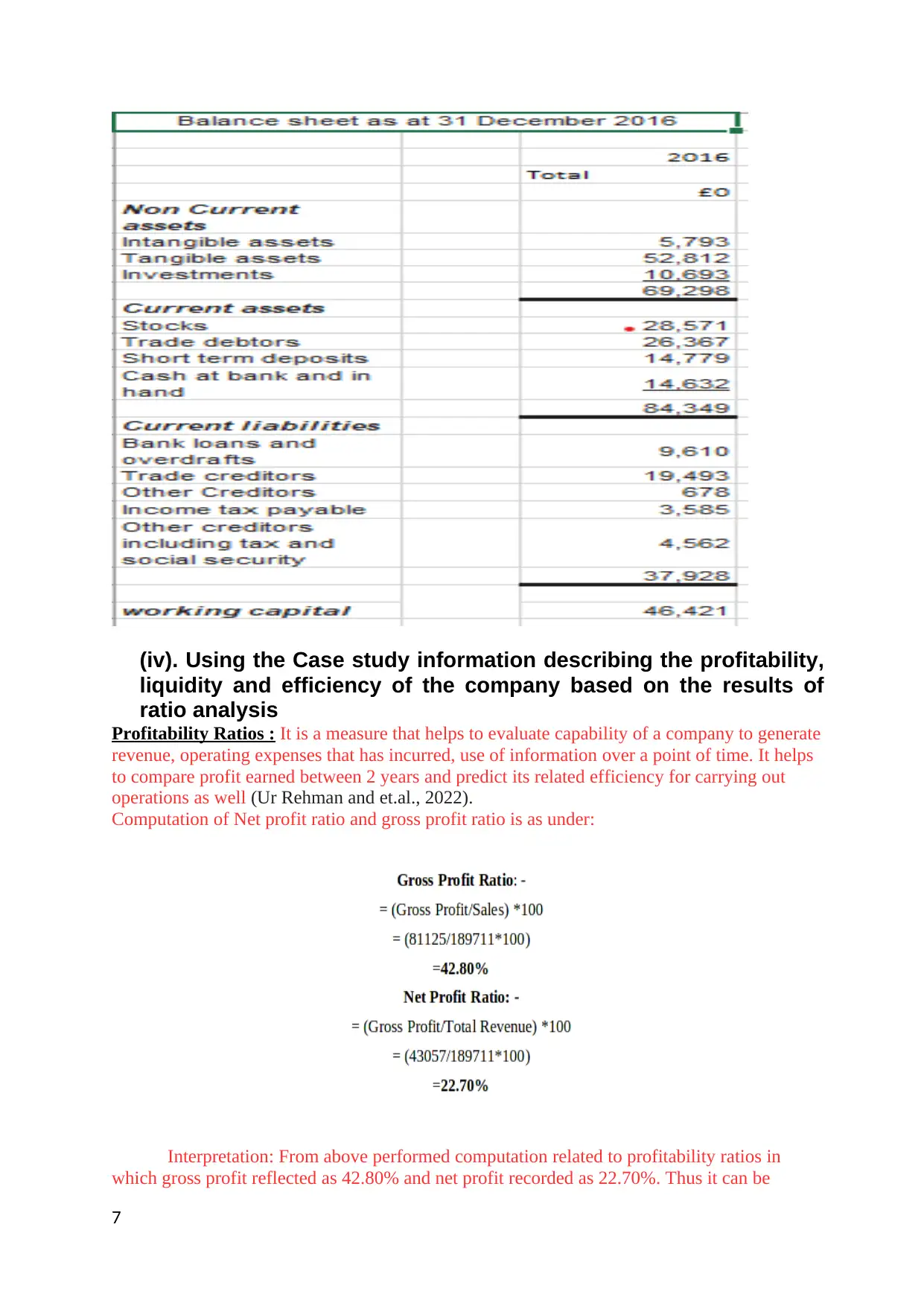
(iv). Using the Case study information describing the profitability,
liquidity and efficiency of the company based on the results of
ratio analysis
Profitability Ratios : It is a measure that helps to evaluate capability of a company to generate
revenue, operating expenses that has incurred, use of information over a point of time. It helps
to compare profit earned between 2 years and predict its related efficiency for carrying out
operations as well (Ur Rehman and et.al., 2022).
Computation of Net profit ratio and gross profit ratio is as under:
Interpretation: From above performed computation related to profitability ratios in
which gross profit reflected as 42.80% and net profit recorded as 22.70%. Thus it can be
7
liquidity and efficiency of the company based on the results of
ratio analysis
Profitability Ratios : It is a measure that helps to evaluate capability of a company to generate
revenue, operating expenses that has incurred, use of information over a point of time. It helps
to compare profit earned between 2 years and predict its related efficiency for carrying out
operations as well (Ur Rehman and et.al., 2022).
Computation of Net profit ratio and gross profit ratio is as under:
Interpretation: From above performed computation related to profitability ratios in
which gross profit reflected as 42.80% and net profit recorded as 22.70%. Thus it can be
7
Paraphrase This Document
Need a fresh take? Get an instant paraphrase of this document with our AI Paraphraser
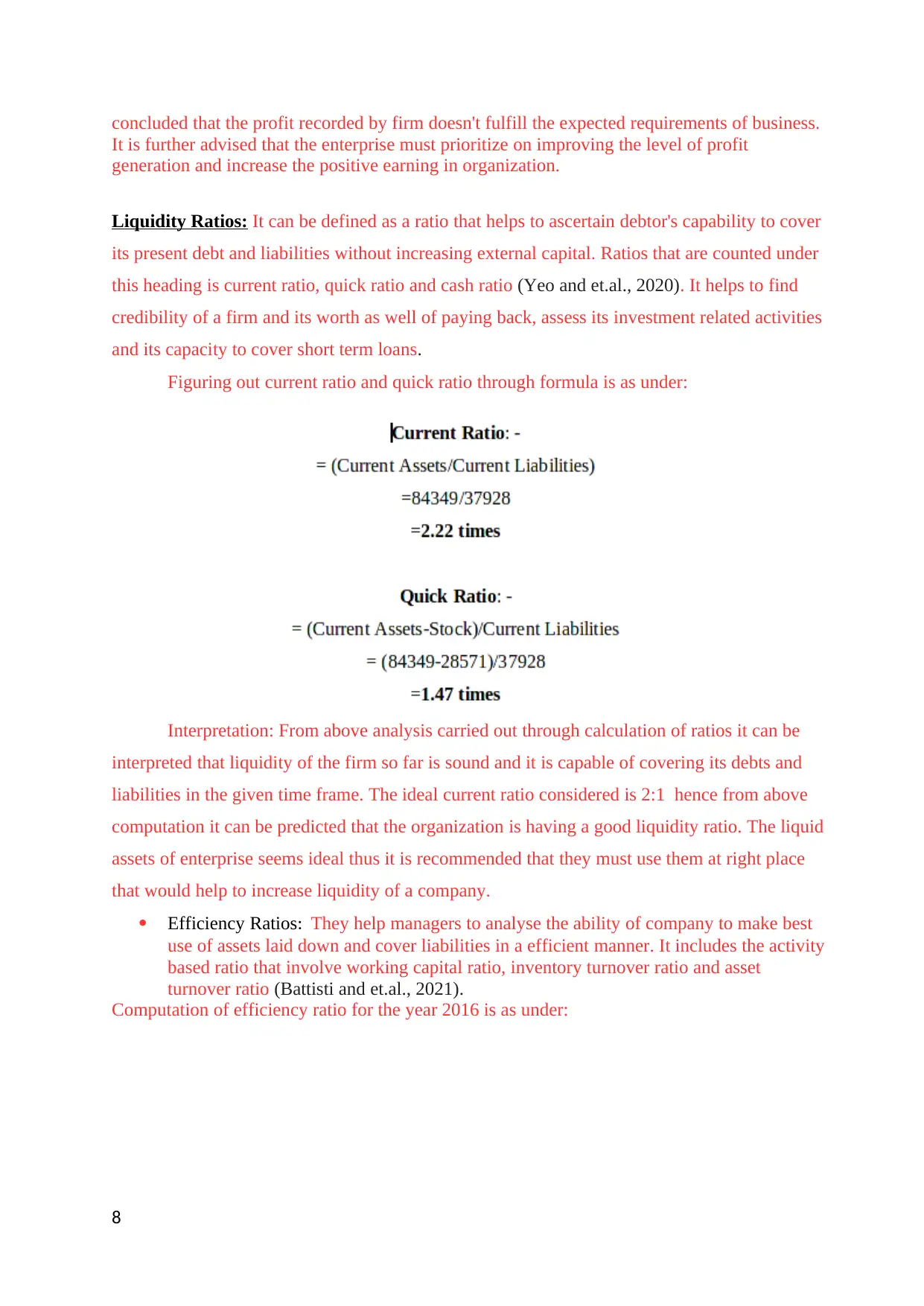
concluded that the profit recorded by firm doesn't fulfill the expected requirements of business.
It is further advised that the enterprise must prioritize on improving the level of profit
generation and increase the positive earning in organization.
Liquidity Ratios: It can be defined as a ratio that helps to ascertain debtor's capability to cover
its present debt and liabilities without increasing external capital. Ratios that are counted under
this heading is current ratio, quick ratio and cash ratio (Yeo and et.al., 2020). It helps to find
credibility of a firm and its worth as well of paying back, assess its investment related activities
and its capacity to cover short term loans.
Figuring out current ratio and quick ratio through formula is as under:
Interpretation: From above analysis carried out through calculation of ratios it can be
interpreted that liquidity of the firm so far is sound and it is capable of covering its debts and
liabilities in the given time frame. The ideal current ratio considered is 2:1 hence from above
computation it can be predicted that the organization is having a good liquidity ratio. The liquid
assets of enterprise seems ideal thus it is recommended that they must use them at right place
that would help to increase liquidity of a company.
Efficiency Ratios: They help managers to analyse the ability of company to make best
use of assets laid down and cover liabilities in a efficient manner. It includes the activity
based ratio that involve working capital ratio, inventory turnover ratio and asset
turnover ratio (Battisti and et.al., 2021).
Computation of efficiency ratio for the year 2016 is as under:
8
It is further advised that the enterprise must prioritize on improving the level of profit
generation and increase the positive earning in organization.
Liquidity Ratios: It can be defined as a ratio that helps to ascertain debtor's capability to cover
its present debt and liabilities without increasing external capital. Ratios that are counted under
this heading is current ratio, quick ratio and cash ratio (Yeo and et.al., 2020). It helps to find
credibility of a firm and its worth as well of paying back, assess its investment related activities
and its capacity to cover short term loans.
Figuring out current ratio and quick ratio through formula is as under:
Interpretation: From above analysis carried out through calculation of ratios it can be
interpreted that liquidity of the firm so far is sound and it is capable of covering its debts and
liabilities in the given time frame. The ideal current ratio considered is 2:1 hence from above
computation it can be predicted that the organization is having a good liquidity ratio. The liquid
assets of enterprise seems ideal thus it is recommended that they must use them at right place
that would help to increase liquidity of a company.
Efficiency Ratios: They help managers to analyse the ability of company to make best
use of assets laid down and cover liabilities in a efficient manner. It includes the activity
based ratio that involve working capital ratio, inventory turnover ratio and asset
turnover ratio (Battisti and et.al., 2021).
Computation of efficiency ratio for the year 2016 is as under:
8
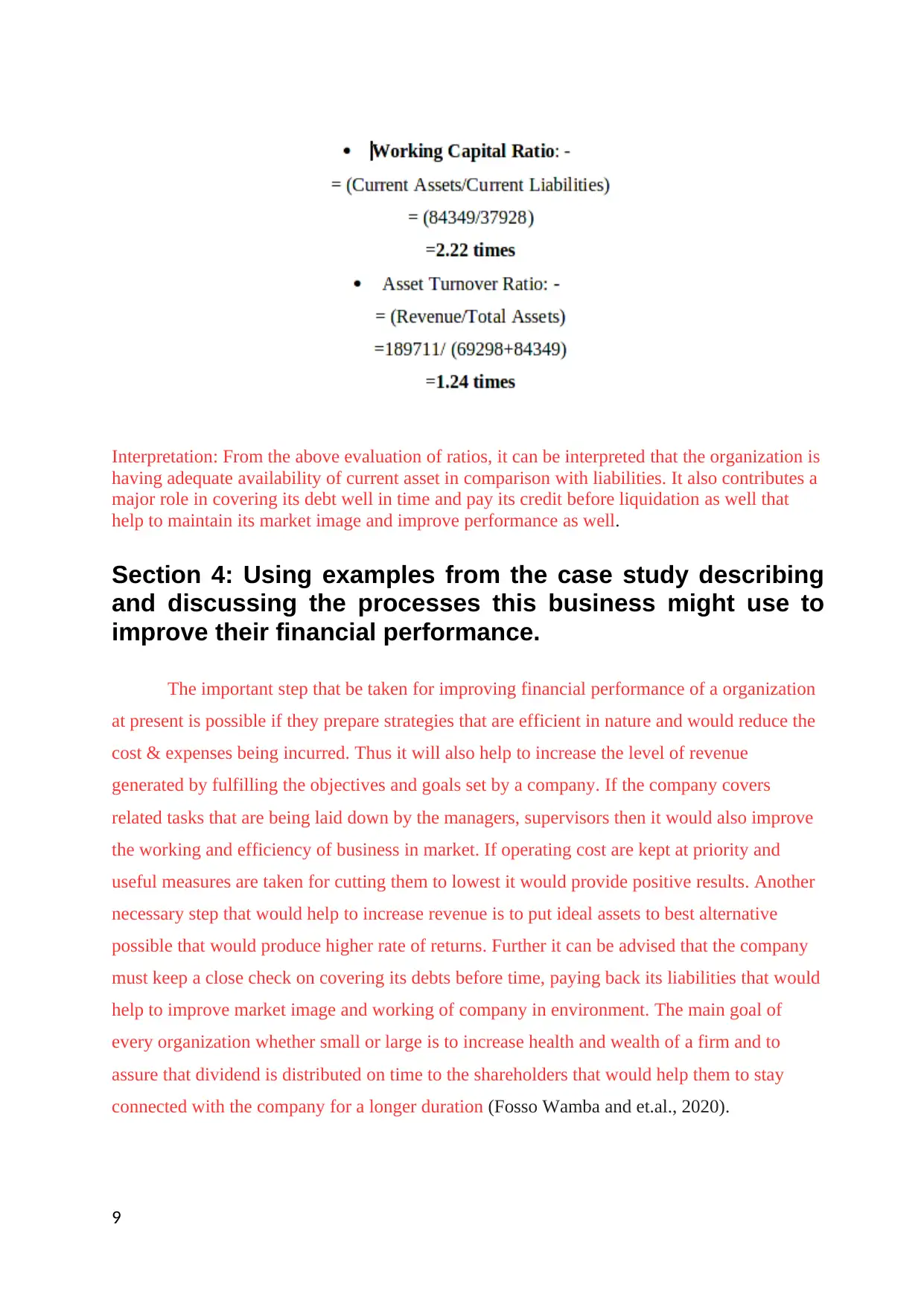
Interpretation: From the above evaluation of ratios, it can be interpreted that the organization is
having adequate availability of current asset in comparison with liabilities. It also contributes a
major role in covering its debt well in time and pay its credit before liquidation as well that
help to maintain its market image and improve performance as well.
Section 4: Using examples from the case study describing
and discussing the processes this business might use to
improve their financial performance.
The important step that be taken for improving financial performance of a organization
at present is possible if they prepare strategies that are efficient in nature and would reduce the
cost & expenses being incurred. Thus it will also help to increase the level of revenue
generated by fulfilling the objectives and goals set by a company. If the company covers
related tasks that are being laid down by the managers, supervisors then it would also improve
the working and efficiency of business in market. If operating cost are kept at priority and
useful measures are taken for cutting them to lowest it would provide positive results. Another
necessary step that would help to increase revenue is to put ideal assets to best alternative
possible that would produce higher rate of returns. Further it can be advised that the company
must keep a close check on covering its debts before time, paying back its liabilities that would
help to improve market image and working of company in environment. The main goal of
every organization whether small or large is to increase health and wealth of a firm and to
assure that dividend is distributed on time to the shareholders that would help them to stay
connected with the company for a longer duration (Fosso Wamba and et.al., 2020).
9
having adequate availability of current asset in comparison with liabilities. It also contributes a
major role in covering its debt well in time and pay its credit before liquidation as well that
help to maintain its market image and improve performance as well.
Section 4: Using examples from the case study describing
and discussing the processes this business might use to
improve their financial performance.
The important step that be taken for improving financial performance of a organization
at present is possible if they prepare strategies that are efficient in nature and would reduce the
cost & expenses being incurred. Thus it will also help to increase the level of revenue
generated by fulfilling the objectives and goals set by a company. If the company covers
related tasks that are being laid down by the managers, supervisors then it would also improve
the working and efficiency of business in market. If operating cost are kept at priority and
useful measures are taken for cutting them to lowest it would provide positive results. Another
necessary step that would help to increase revenue is to put ideal assets to best alternative
possible that would produce higher rate of returns. Further it can be advised that the company
must keep a close check on covering its debts before time, paying back its liabilities that would
help to improve market image and working of company in environment. The main goal of
every organization whether small or large is to increase health and wealth of a firm and to
assure that dividend is distributed on time to the shareholders that would help them to stay
connected with the company for a longer duration (Fosso Wamba and et.al., 2020).
9
⊘ This is a preview!⊘
Do you want full access?
Subscribe today to unlock all pages.

Trusted by 1+ million students worldwide

Conclusion
From the above prepared report it can be concluded that Financial management plays an
important as well as vital role in functioning and running of a business in market. It helps to
manage planning, directing, controlling and monitoring of finance related operations. It guides
in preparation of statements such as balance sheet, profit and loss and income records as well.
It further assist in calculation of ratio for ascertainment of liquidating funds and examine the
efficiency of work carried by a firm over a period of time.
10
From the above prepared report it can be concluded that Financial management plays an
important as well as vital role in functioning and running of a business in market. It helps to
manage planning, directing, controlling and monitoring of finance related operations. It guides
in preparation of statements such as balance sheet, profit and loss and income records as well.
It further assist in calculation of ratio for ascertainment of liquidating funds and examine the
efficiency of work carried by a firm over a period of time.
10
Paraphrase This Document
Need a fresh take? Get an instant paraphrase of this document with our AI Paraphraser
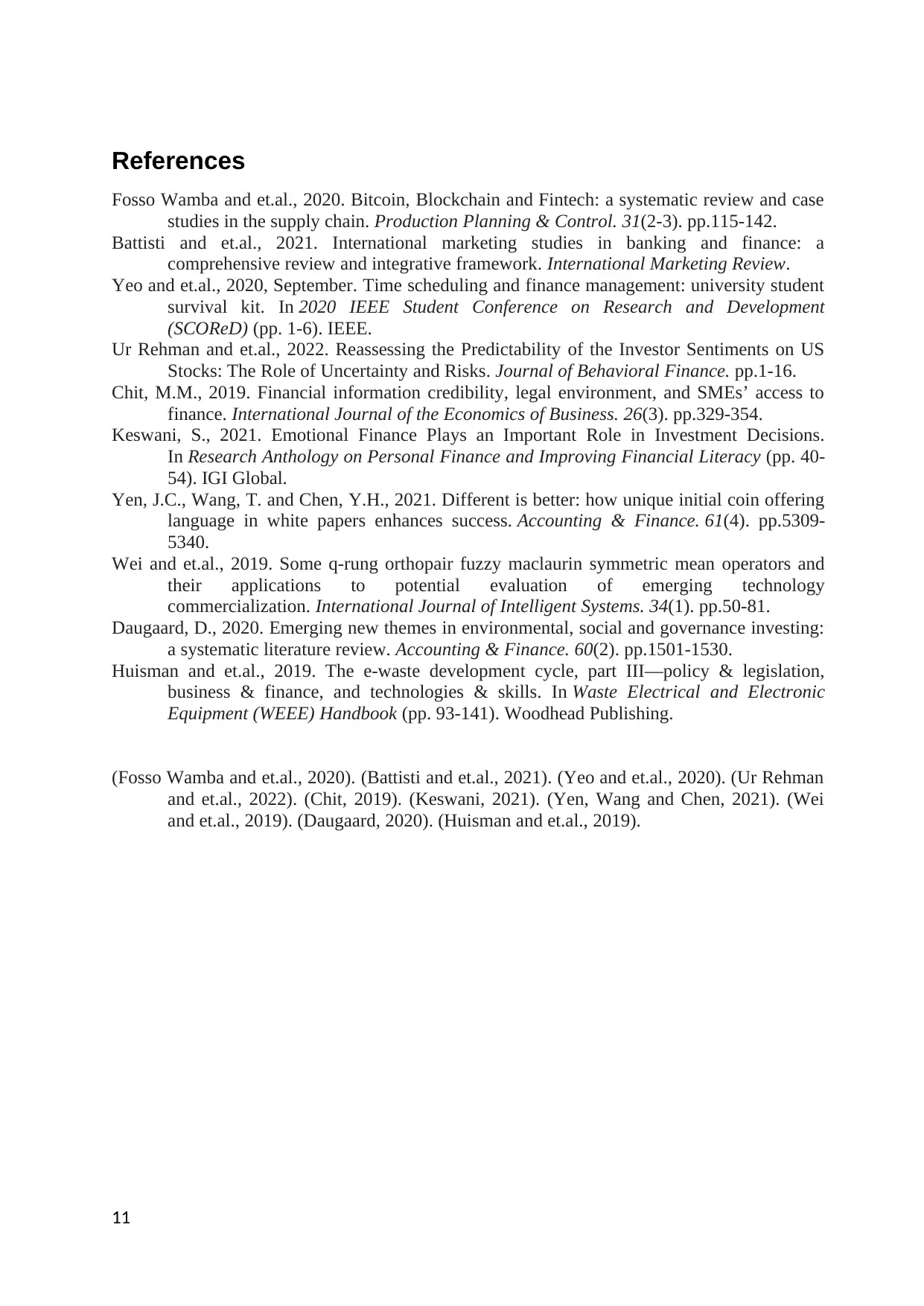
References
Fosso Wamba and et.al., 2020. Bitcoin, Blockchain and Fintech: a systematic review and case
studies in the supply chain. Production Planning & Control. 31(2-3). pp.115-142.
Battisti and et.al., 2021. International marketing studies in banking and finance: a
comprehensive review and integrative framework. International Marketing Review.
Yeo and et.al., 2020, September. Time scheduling and finance management: university student
survival kit. In 2020 IEEE Student Conference on Research and Development
(SCOReD) (pp. 1-6). IEEE.
Ur Rehman and et.al., 2022. Reassessing the Predictability of the Investor Sentiments on US
Stocks: The Role of Uncertainty and Risks. Journal of Behavioral Finance. pp.1-16.
Chit, M.M., 2019. Financial information credibility, legal environment, and SMEs’ access to
finance. International Journal of the Economics of Business. 26(3). pp.329-354.
Keswani, S., 2021. Emotional Finance Plays an Important Role in Investment Decisions.
In Research Anthology on Personal Finance and Improving Financial Literacy (pp. 40-
54). IGI Global.
Yen, J.C., Wang, T. and Chen, Y.H., 2021. Different is better: how unique initial coin offering
language in white papers enhances success. Accounting & Finance. 61(4). pp.5309-
5340.
Wei and et.al., 2019. Some q‐rung orthopair fuzzy maclaurin symmetric mean operators and
their applications to potential evaluation of emerging technology
commercialization. International Journal of Intelligent Systems. 34(1). pp.50-81.
Daugaard, D., 2020. Emerging new themes in environmental, social and governance investing:
a systematic literature review. Accounting & Finance. 60(2). pp.1501-1530.
Huisman and et.al., 2019. The e-waste development cycle, part III—policy & legislation,
business & finance, and technologies & skills. In Waste Electrical and Electronic
Equipment (WEEE) Handbook (pp. 93-141). Woodhead Publishing.
(Fosso Wamba and et.al., 2020). (Battisti and et.al., 2021). (Yeo and et.al., 2020). (Ur Rehman
and et.al., 2022). (Chit, 2019). (Keswani, 2021). (Yen, Wang and Chen, 2021). (Wei
and et.al., 2019). (Daugaard, 2020). (Huisman and et.al., 2019).
11
Fosso Wamba and et.al., 2020. Bitcoin, Blockchain and Fintech: a systematic review and case
studies in the supply chain. Production Planning & Control. 31(2-3). pp.115-142.
Battisti and et.al., 2021. International marketing studies in banking and finance: a
comprehensive review and integrative framework. International Marketing Review.
Yeo and et.al., 2020, September. Time scheduling and finance management: university student
survival kit. In 2020 IEEE Student Conference on Research and Development
(SCOReD) (pp. 1-6). IEEE.
Ur Rehman and et.al., 2022. Reassessing the Predictability of the Investor Sentiments on US
Stocks: The Role of Uncertainty and Risks. Journal of Behavioral Finance. pp.1-16.
Chit, M.M., 2019. Financial information credibility, legal environment, and SMEs’ access to
finance. International Journal of the Economics of Business. 26(3). pp.329-354.
Keswani, S., 2021. Emotional Finance Plays an Important Role in Investment Decisions.
In Research Anthology on Personal Finance and Improving Financial Literacy (pp. 40-
54). IGI Global.
Yen, J.C., Wang, T. and Chen, Y.H., 2021. Different is better: how unique initial coin offering
language in white papers enhances success. Accounting & Finance. 61(4). pp.5309-
5340.
Wei and et.al., 2019. Some q‐rung orthopair fuzzy maclaurin symmetric mean operators and
their applications to potential evaluation of emerging technology
commercialization. International Journal of Intelligent Systems. 34(1). pp.50-81.
Daugaard, D., 2020. Emerging new themes in environmental, social and governance investing:
a systematic literature review. Accounting & Finance. 60(2). pp.1501-1530.
Huisman and et.al., 2019. The e-waste development cycle, part III—policy & legislation,
business & finance, and technologies & skills. In Waste Electrical and Electronic
Equipment (WEEE) Handbook (pp. 93-141). Woodhead Publishing.
(Fosso Wamba and et.al., 2020). (Battisti and et.al., 2021). (Yeo and et.al., 2020). (Ur Rehman
and et.al., 2022). (Chit, 2019). (Keswani, 2021). (Yen, Wang and Chen, 2021). (Wei
and et.al., 2019). (Daugaard, 2020). (Huisman and et.al., 2019).
11
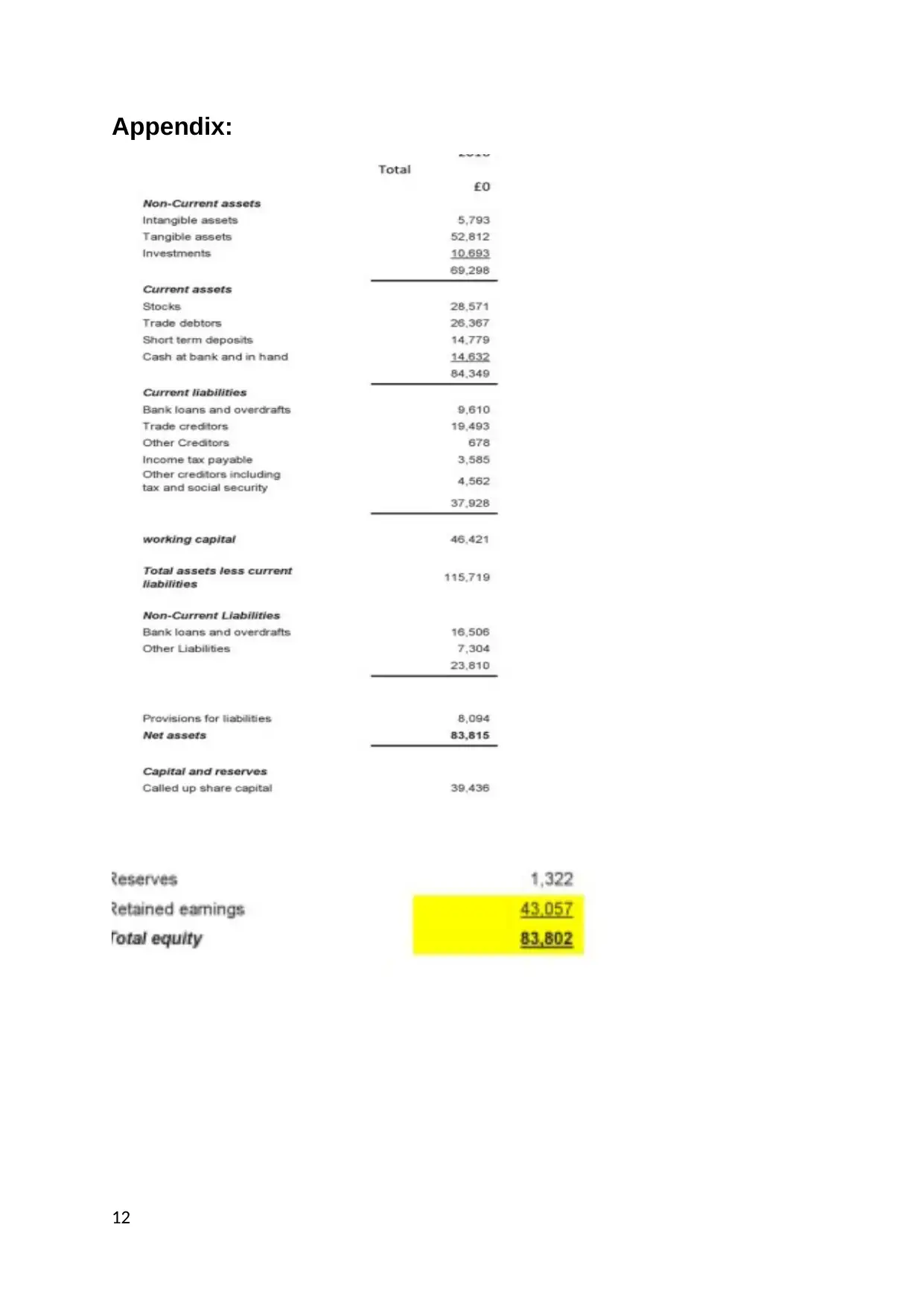
Appendix:
12
12
⊘ This is a preview!⊘
Do you want full access?
Subscribe today to unlock all pages.

Trusted by 1+ million students worldwide
1 out of 13
Related Documents
Your All-in-One AI-Powered Toolkit for Academic Success.
+13062052269
info@desklib.com
Available 24*7 on WhatsApp / Email
![[object Object]](/_next/static/media/star-bottom.7253800d.svg)
Unlock your academic potential
Copyright © 2020–2025 A2Z Services. All Rights Reserved. Developed and managed by ZUCOL.


